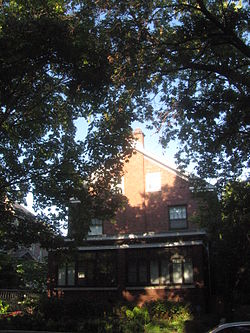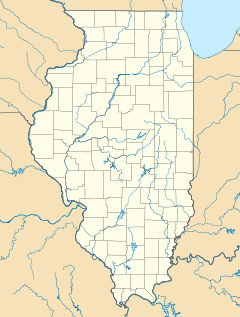- Arthur H. Compton House
-
Compton, Arthur H., House
Location: Chicago, IL Coordinates: 41°47′31.16″N 87°35′46.63″W / 41.7919889°N 87.5962861°WCoordinates: 41°47′31.16″N 87°35′46.63″W / 41.7919889°N 87.5962861°W Built: 1925 Architect: Tetter,M. Governing body: Private NRHP Reference#: 76000687 [1] Significant dates Added to NRHP: May 11, 1976 Designated NHL: May 11, 1976[2] The Arthur H. Compton House, located at 5637 South Woodlawn Avenue in Chicago, Illinois, was the residence of professor Arthur Compton from the late 1920s until 1945. Arthur Compton was a physicist who discovered the Compton Effect, proving that light has both a particle and a wave aspect. Compton received the Nobel Prize in Physics in 1927 for this discovery.[2] Arthur was born in Wooster,OH on September 10, 1892 to the parents of Elias Compton, philosophy professor, and Otelia Catheryne Augspurger Compton. Compton died on March 15, 1962, his burial took place in Wooster Cemetery, Wooster, OH.
Accomplishments
- Rumford Prize 1926
- Nobel Prize for Physics 1927
- Matteucci Medal 1930
- Hughes Medal 1940
- St. Louis Walk of Fame
- General Electric Consulting Physicist (1926-45)
- Westinghouse Research Engineer (1917-19)
- American Association for the Advancement of Science President (1942)
- American Association of Scientific Workers President (1939-40)
- American Physical Society President (1934)
- Argonne National Laboratory Board of Governors (1945)
- Brookings Institution Board of Trustees (1956-59)
- Carnegie Foundation for the Advancement of Teaching Board of Trustees (1949-53)
- Chicago Museum of Science and Industry Board of Trustees (1953-62)
- Committee for Economic Development Board of Trustees(1949-58)
- Institute of International Education
- National Academy of Sciences Board of Trustees (1949-61)
- National Conference of Christians and Jews Co-Chairman (1938-47),
- Board of Directors (1947-58)
- Smithsonian Institution Board of Regents (1950-62)
- Urban League (1954-60)
- Young Men's Christian Association
- Manhattan Project Director, Metallurgical Laboratory
- Lunar Crater (named for Arthur & Karl T. Compton)
References
- ^ "National Register Information System". National Register of Historic Places. National Park Service. 2007-01-23. http://nrhp.focus.nps.gov/natreg/docs/All_Data.html.
- ^ a b "Compton, Arthur H,House". National Historic Landmark summary listing. National Park Service. http://tps.cr.nps.gov/nhl/detail.cfm?ResourceId=1613&ResourceType=Building. Retrieved 2007-05-12.
U.S. National Register of Historic Places Topics Lists by states Alabama • Alaska • Arizona • Arkansas • California • Colorado • Connecticut • Delaware • Florida • Georgia • Hawaii • Idaho • Illinois • Indiana • Iowa • Kansas • Kentucky • Louisiana • Maine • Maryland • Massachusetts • Michigan • Minnesota • Mississippi • Missouri • Montana • Nebraska • Nevada • New Hampshire • New Jersey • New Mexico • New York • North Carolina • North Dakota • Ohio • Oklahoma • Oregon • Pennsylvania • Rhode Island • South Carolina • South Dakota • Tennessee • Texas • Utah • Vermont • Virginia • Washington • West Virginia • Wisconsin • WyomingLists by territories Lists by associated states Other City of Chicago Architecture · Beaches · Climate · Colleges and Universities · Community areas · Culture · Demographics · Economy · Flag · Freeways · Geography · Government · History · Landmarks · Literature · Media · Music · Neighborhoods · Parks · Public schools · Skyscrapers · Sports · Theatre · Transportation
 Category ·
Category ·  PortalCategories:
PortalCategories:- National Historic Landmarks in Illinois
- National Register of Historic Places in Chicago, Illinois
- Landmarks in Chicago, Illinois
- Houses in Chicago, Illinois
- Illinois building and structure stubs
- Illinois Registered Historic Place stubs
- Chicago, Illinois stubs
Wikimedia Foundation. 2010.


